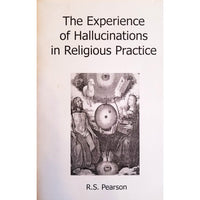- Description
contains excerpts from The Experience of Hallucinations in Religious Practice
"The Experience of Hallucinations in Religious Practice" by R.S. Pearson is the one of the first books to help distinguish what is a spiritual experience and what may be merely a type of dream phenomena or hallucination. The author discusses how much religious and so-called esoteric experience takes place in the state of consciousness within the brain that is similar to the dream state in human beings.
This book is written by someone who has a religious perspective, yet it is non-denomenational and not offensive to those of any faith. It is not written in a technical style, yet still provides challenging material. Today, a large percentage of religious thought encourages people to have extra-sensory experiences. Medical science has also proven both the value of religious faith in some people via statistical studies, and also the fact that some religious experiences fall into the same category as hallucinations or dreams. Because of the many popular celebrity psychics, some of whom even talk to the dead on TV, many come to believe that whatever you experience is what you imagine it to be. But for one who was taught by many different religious teachers, and did a detailed study of religious literature, Pearson felt it necessary to write about the other side of the picture. "Like the great religions teach, many are going to have to learn by personal experience that it's often best to not believe in these experiences," Pearson says. "The problem is, that there are psychological studies that show the longer that you hallucinate, the more your IQ can decrease."
The author believes that today's spiritual climate is often dangerous, because there isn't much sophistication in understanding what people can often experience when they open themselves up to spiritual practices. Most of the traditional religious leaders, whether they be Christians, Jews, Islamic, Zen Buddhist monks, or yogis, teach not to make much of so-called paranormal experiences. Such experiences have traditionally been said to be possibly dangerous. However, to some of today's modern writers, these experiences become the most important part of their spirituality. The author has done some charitable work among the homeless of Seattle and he recognizes that many of the homeless are mentally ill and are experiencing hallucinations. "Most likely the homeless who are hallucinating are believing that they are having religious experiences. Often they already feel condemned by God because they hallucinate God condemning them." He realizes that since there was no book written when he was younger on this subject, that a book like his that takes both a religious and psychological perspective fills an important need. He says, that, on the contrary, only books were written encouraging people to hallucinate. Pearson states, "I tried to write this book for the biggest audience possible. I state clearly up front that I am not a trained psychologist or psychiatrist. Some proofreaders were expecting me to write an academic book that referenced every statement, but many readers are intimidated by such books. I wrote a book that will inform most people's understanding of psychology but one which has no technical medical information from brain science, so as to not intimidate people in the reading process."
Although written from a spiritual perspective, the author has tried to remove his own specific personal beliefs from this book to create an interfaith work.
Author/Artist: R.S. Pearson
Publisher: Telical Books
Page Count: 28pp
Size: 5.5 x 8.5
Notes: b/w, saddle-stitched
Date of Publication: 2007
ISBN: 978-0974813950


